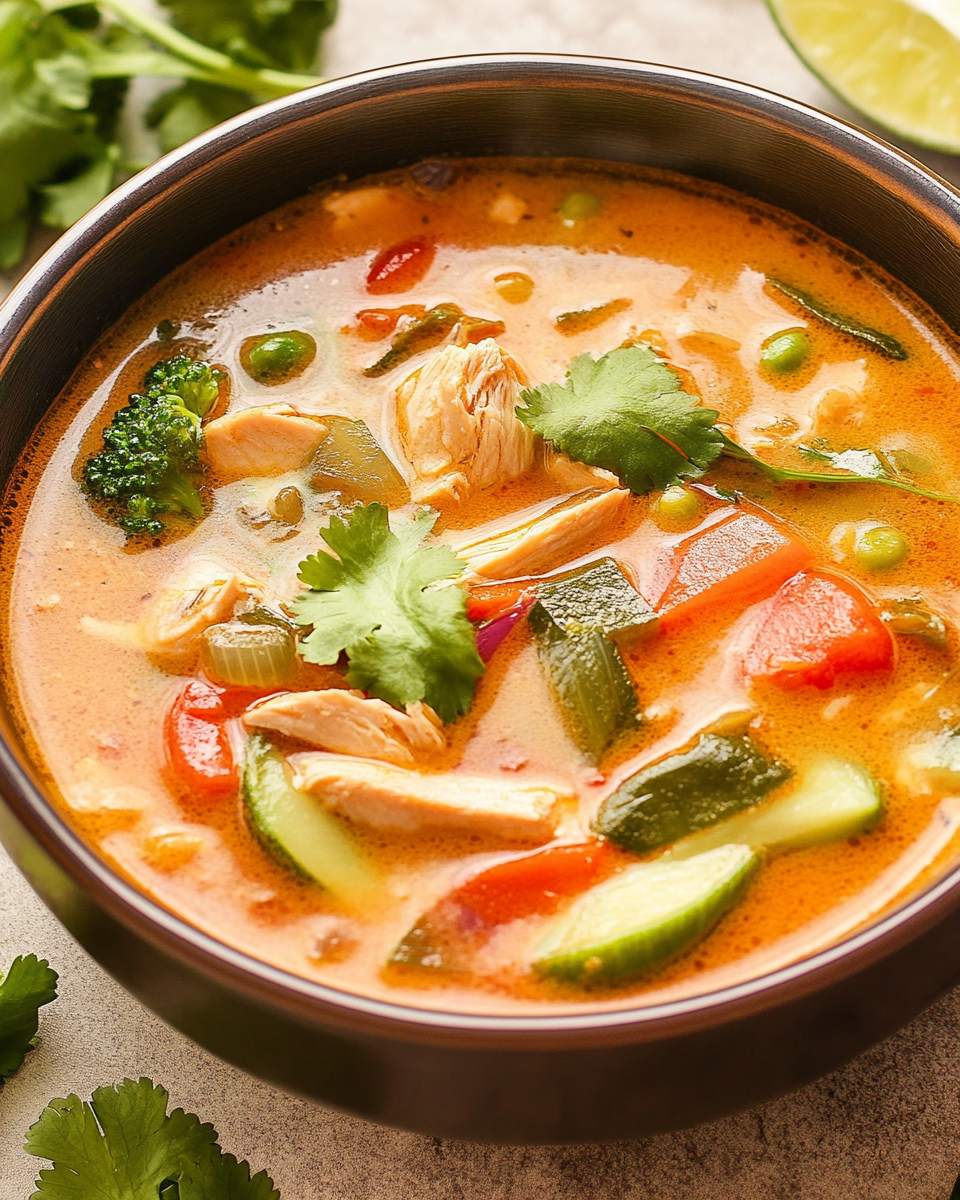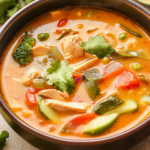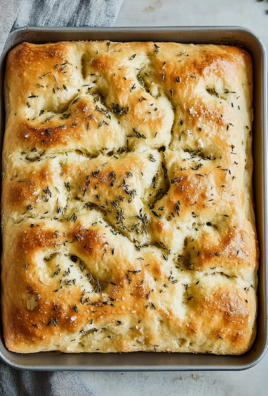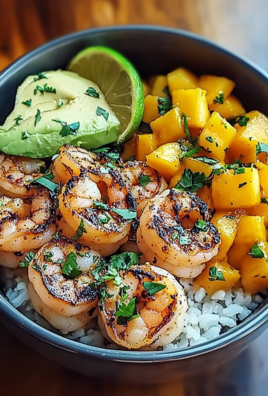Thai Coconut Curry Chicken Soup is the perfect blend of comfort, nutrition, and bold flavor. Inspired by traditional Thai cuisine, this one-pot dish combines tender pieces of chicken, vibrant vegetables, creamy coconut milk, and spicy red curry paste for a rich and aromatic experience.
Naturally dairy-free, gluten-free, Whole30, and paleo-friendly, this soup caters to a wide range of dietary needs while delivering a deeply satisfying taste. It’s ideal for cold nights, quick weeknight dinners, or meal prep sessions where you want something hearty and wholesome that doesn’t skimp on flavor.

Why You’ll Love This Thai Coconut Curry Chicken Soup
- Naturally dairy-free and gluten-free without sacrificing creaminess or depth of flavor
- Ready in just under 40 minutes with minimal prep
- Perfect for one-pot meals and batch cooking
- Easily customizable with your favorite proteins or extra vegetables
- Rich in immune-boosting ingredients like garlic, ginger, and broth
Whether you are following a specific dietary lifestyle or simply craving a delicious bowl of comforting soup, this recipe checks all the boxes. It balances sweet, spicy, sour, and savory notes just like a great Thai dish should.
Preparation Phase & Tools to Use
Before cooking, it’s important to gather and prepare your tools and ingredients. A smooth cooking experience begins with having everything organized and ready to go.
Essential Tools and Equipment
- Large soup pot or Dutch oven: For sautéing and simmering all ingredients evenly
- Chef’s knife: To slice vegetables and chicken cleanly and efficiently
- Cutting board: Provides a stable, sanitary surface for prepping ingredients
- Measuring cups and spoons: Ensures accuracy in flavor and consistency
- Wooden spoon or silicone spatula: Ideal for stirring without scratching cookware
- Citrus juicer (optional): Helps extract maximum juice from limes with ease
Importance of Each Tool
Each of these tools plays a crucial role in ensuring your cooking process is seamless. Using a heavy-bottomed pot or Dutch oven allows the curry to simmer without burning, and sharp knives help with uniform vegetable cuts, ensuring even cooking and presentation.
Preparation Tips
- Prep all vegetables and ingredients before turning on the heat to stay organized
- Use full-fat coconut milk for the creamiest, most satisfying soup texture
- Slice the chicken into small, even pieces to ensure quick and consistent cooking
- Always bloom the curry paste in oil to release its full aroma and deepen the flavor
- Don’t overcrowd the pot when sautéing vegetables; this helps them soften evenly
Ingredients List
Base Ingredients
- 2 tablespoons avocado oil or toasted sesame oil
- ½ medium onion, thinly sliced or chopped
- 3 cloves garlic, chopped
- 1 teaspoon fresh ginger, grated or finely chopped
- ¼ cup red curry paste (or green curry paste as an alternative)
Vegetables
- 1 red bell pepper, thinly sliced
- 2 carrots, thinly sliced
- 1 zucchini, halved and sliced
- 2 cups broccoli florets
Liquids
- 4 cups low-sodium chicken broth
- 1 (13.5 oz) can full-fat coconut milk
- 3 tablespoons coconut aminos
Protein
- 1 pound chicken breast, cut into bite-sized pieces
Finishing Touches
- 1 teaspoon salt, or to taste
- Juice of 1 lime
Optional Garnishes
- Fresh cilantro or basil
- Thinly sliced green onions
- Chili oil
- Chopped cashews
- Extra lime wedges
Step-by-Step Instructions
- Sauté the Aromatics
Heat the oil in a large pot over medium heat. Add the onion, garlic, and ginger. Cook for 2 minutes, stirring frequently, until fragrant and soft. - Add the Curry Paste
Stir in the curry paste and let it cook for 1 minute. This step helps bloom the spices and intensify the flavor. - Cook the Vegetables
Add bell pepper, carrots, and zucchini. Stir to coat with the curry paste and sauté for 3 to 4 minutes until slightly softened. - Add Broth and Coconut Milk
Pour in the chicken broth, coconut milk, and coconut aminos. Increase heat to medium-high and bring to a simmer. - Add Chicken and Broccoli
Stir in the chicken and broccoli. Simmer gently for 5 to 6 minutes, or until the chicken is cooked through and the broccoli is tender. - Season and Finish
Add lime juice and salt. Taste and adjust seasoning as needed. - Serve and Garnish
Ladle into bowls and top with fresh herbs, green onions, chili oil, or chopped cashews as desired.
Serving Suggestions
Thai Coconut Curry Chicken Soup is incredibly versatile, making it easy to serve in a variety of ways depending on the occasion. Its creamy coconut broth and fragrant spices pair well with both traditional Thai accompaniments and fresh, simple sides. Whether you want a light lunch or a full dinner, here are some delicious ways to serve this soup.
Over Rice or Noodles
- Serve over a scoop of jasmine or basmati rice for a heartier meal
- Add cooked rice noodles or glass noodles to transform it into a noodle soup
Fresh Garnishes
- Top with chopped fresh cilantro or Thai basil for a burst of flavor
- Add a drizzle of chili oil for extra heat
- Squeeze additional lime juice just before serving for brightness
- Sprinkle chopped cashews or peanuts for crunch
For Meal Prep
- Divide into glass containers with a scoop of rice or veggies for ready-to-go lunches
- Store with garnishes on the side to maintain freshness and texture
This soup also works beautifully as a standalone dish due to its well-balanced flavor profile, but pairing it with complementary sides takes the meal to the next level.
Common Mistakes to Avoid
Even though this recipe is straightforward, a few common mistakes can affect the final taste and texture. Avoiding these will help you perfect the dish and bring out the best in each ingredient.
Skipping the Curry Paste Blooming Step
Blooming the curry paste in oil before adding other ingredients is essential. It deepens the flavor and allows the aromatics to release their full potential. If added directly to the broth, the paste can taste flat or underdeveloped.
Using Low-Fat Coconut Milk
Full-fat coconut milk contributes to the soup’s creamy consistency and rich flavor. Light versions can result in a thinner texture and less satisfying mouthfeel.
Overcooking the Chicken
Chicken breast cooks quickly, especially when diced into small pieces. Overcooking will make it tough or dry. To prevent this, keep the simmer gentle and watch the timing closely.
Boiling the Coconut Milk
Bringing the soup to a hard boil after adding coconut milk can cause it to separate or become oily. Instead, maintain a gentle simmer to keep the broth smooth and cohesive.
Not Adjusting Seasoning at the End
Always taste the soup before serving. Depending on the saltiness of your broth or the strength of your curry paste, you may need to add more lime juice or salt to achieve balance.
Side Dish Recommendations
To create a complete and satisfying meal, consider pairing this Thai Coconut Curry Chicken Soup with one or more of these side dishes. Each one complements the flavor and texture of the soup without overpowering it.
1. Thai Cucumber Salad
A refreshing side made with thinly sliced cucumbers, rice vinegar, sesame oil, and a sprinkle of red pepper flakes. This cooling salad balances the heat of the curry.
2. Coconut Jasmine Rice
Aromatic jasmine rice cooked with a splash of coconut milk creates a mild, creamy base that enhances the soup’s tropical notes.
3. Mango Sticky Rice (as a light dessert)
Sweet and creamy mango sticky rice provides a naturally gluten-free dessert that complements the spice and heat of the soup.
4. Thai Spring Rolls
Filled with vegetables and served with a light dipping sauce, these rolls add texture and variety to the meal.
5. Spicy Papaya Salad (Som Tum)
This crunchy, tangy salad made from green papaya, lime, and chilies offers a bold contrast to the soup’s creamy consistency.
6. Grilled Lemongrass Chicken Skewers
These skewers add extra protein and a charred flavor that pairs beautifully with the light broth.
7. Steamed Bok Choy with Garlic
A simple side of steamed greens with garlic oil provides extra nutrients without complicating the plate.
8. Crispy Tofu Bites with Sweet Chili Sauce
For plant-based diners or as an appetizer, crispy tofu adds crunch and can soak up the curry flavor if dipped in the broth.
Each of these side dishes brings out a different dimension of the soup, from crunch to sweetness, creating a balanced and memorable meal.
Final Thoughts on Enhancing the Recipe
This recipe is highly adaptable, making it perfect for cooks who want to tweak it to their preferences. You can experiment with different types of curry paste such as yellow or green, use spiralized vegetables instead of sliced ones, or add ingredients like spinach, mushrooms, or bamboo shoots for extra texture and nutrition.
For a spicier variation, stir in some Thai chili flakes or sliced bird’s eye chilies. To mellow it out for kids or spice-sensitive guests, reduce the amount of curry paste and increase the coconut milk slightly.
Learning to perfect this soup is all about balance — between heat and sweetness, creaminess and acidity, protein and vegetables. Once you’ve mastered the method, you’ll find yourself returning to this dish again and again.
Recipe Tips and Customizations
Thai Coconut Curry Chicken Soup is not only flavorful and nourishing, but also incredibly flexible. Once you master the base, you can adjust the recipe to suit your taste preferences, dietary needs, or the ingredients you have on hand.
Substitutions and Variations
- Protein swaps: Replace chicken breast with boneless chicken thighs, shrimp, tofu, or tempeh for variety. Keep in mind cooking times may vary slightly.
- Vegetable additions: This soup works well with mushrooms, spinach, snap peas, kale, or baby corn. Add heartier vegetables early in the cooking process and leafy greens at the end.
- Change the curry paste: Use green curry paste for a milder, slightly sweeter flavor or yellow curry paste for a richer, more earthy base.
- Spice adjustments: Add Thai chili flakes or sliced bird’s eye chili for more heat. For a milder version, reduce the amount of curry paste or use a less spicy brand.
- Low-carb option: Replace carrots and bell peppers with lower-carb vegetables like zucchini, spinach, or cauliflower for a keto-friendly version.
Pro Tips for Maximum Flavor
- Always bloom the curry paste in oil to release essential oils and deepen the flavor.
- Use freshly grated ginger and garlic for a stronger, more aromatic base.
- Fresh lime juice is essential. Bottled lime juice often lacks the brightness needed to cut through the richness of the coconut milk.
- Garnish right before serving to preserve the freshness and texture of herbs and toppings.
These tips ensure your soup has the perfect balance of creaminess, spice, and zest while maintaining a homemade, restaurant-quality finish.
Storage and Reheating Instructions
This soup is ideal for meal prep and stores well both in the refrigerator and freezer. Because it contains no dairy, the broth maintains its texture even after reheating.
Storing in the Refrigerator
- Allow the soup to cool to room temperature before storing.
- Place in an airtight container and refrigerate for up to 5 days.
- Store garnishes separately to maintain their texture.
Freezing Instructions
- Ladle cooled soup into freezer-safe containers or bags, leaving room at the top for expansion.
- Label and date each container.
- Freeze for up to 3 months.
- For best texture, avoid freezing with added garnishes like herbs or nuts.
Reheating Guidelines
- Stovetop: Place the soup in a saucepan and reheat gently over medium heat, stirring occasionally until warmed through.
- Microwave: Heat in a microwave-safe bowl in 60-second intervals, stirring between each round, until hot.
- Avoid boiling the soup when reheating, especially after freezing, as this may cause the coconut milk to separate.
Proper storage and reheating allow you to enjoy this soup over several meals without compromising its flavor or texture.
Frequently Asked Questions (FAQs)
What does Thai Coconut Curry Chicken Soup taste like?
This soup offers a balance of creamy coconut milk, spicy red curry, fresh vegetables, and zesty lime. It’s savory, aromatic, slightly sweet, and mildly spicy, depending on the curry paste used.
Is Thai Coconut Curry Chicken Soup spicy?
The soup has a medium level of heat, mostly from the red curry paste. You can adjust the spiciness by using more or less paste or choosing a milder variety. Additional chili flakes can be added if you prefer more heat.
Can I make this soup vegetarian or vegan?
Yes. Use tofu or tempeh instead of chicken and substitute chicken broth with vegetable broth. Ensure that the curry paste used is vegan-friendly, as some contain shrimp paste or fish sauce.
Is coconut milk essential to the recipe?
Coconut milk is a key component of this soup. It provides creaminess, balances the spice, and gives the dish its signature Thai flavor. Using full-fat coconut milk is highly recommended for the best texture and taste.
Can I make this soup in a slow cooker?
Yes. Combine all ingredients except the lime juice and garnishes in the slow cooker. Cook on low for 6 to 7 hours or on high for 3 to 4 hours. Stir in lime juice at the end, then garnish just before serving.
How do I prevent the coconut milk from separating?
To avoid separation, do not bring the soup to a rolling boil after adding the coconut milk. Instead, keep it at a gentle simmer. Also, avoid excessive stirring once the coconut milk is added.
Final Thoughts
Thai Coconut Curry Chicken Soup is a warming, nourishing, and deeply satisfying dish that suits a variety of dietary lifestyles. Its vibrant balance of flavors makes it a go-to meal for both comfort and health. The rich coconut broth, colorful vegetables, and tender chicken provide a complete meal in a single bowl, while its flexibility allows you to adjust ingredients to your liking.
Whether you’re meal prepping for the week, cooking for your family, or exploring Thai-inspired recipes, this soup offers an easy yet impressive option. With proper storage and a few customization tips, you can enjoy it fresh or reheated with consistently delicious results.
Thai Coconut Curry Chicken Soup (Dairy Free)
Ingredients
- 2 tablespoons avocado oil or toasted sesame oil
- 1/2 medium onion thinly sliced or chopped
- 3 cloves garlic chopped
- 1 teaspoon fresh ginger grated or finely chopped
- 1/4 cup red curry paste or green curry paste
- 1 red bell pepper thinly sliced
- 2 carrots thinly sliced
- 1 medium zucchini halved lengthwise and sliced
- 4 cups chicken broth low sodium preferred
- 1 13.5 oz can full-fat coconut milk
- 3 tablespoons coconut aminos
- 1 pound chicken breast cut into bite-sized pieces
- 2 cups broccoli florets
- 1 teaspoon salt or to taste
- Juice of 1 lime
For Garnish (optional):
- Fresh cilantro or basil
- Red or green onions thinly sliced
- Chili oil
- Chopped cashews
- Extra lime wedges
Instructions
- Sauté aromatics: In a large soup pot, heat oil over medium heat. Add the onion, garlic, and ginger. Cook for about 2 minutes, stirring, until onions soften and garlic is fragrant.
- Add curry paste: Stir in the curry paste and cook for 1 minute, allowing it to bloom and coat the aromatics.
- Cook the veggies: Add bell pepper, carrots, and zucchini. Stir to coat in curry mixture and sauté for 3–4 minutes, until slightly softened.
- Add liquids: Pour in the chicken broth, coconut milk, and coconut aminos. Increase heat to medium-high and bring to a gentle simmer.
- Add chicken and broccoli: Stir in the chicken breast and broccoli florets. Simmer for 5–6 minutes, or until chicken is fully cooked and broccoli is bright green and tender.
- Season and finish: Stir in lime juice and salt to taste. Adjust seasoning as needed.
- Serve: Ladle into bowls and garnish with fresh herbs, onions, chili oil, cashews, and lime wedges as desired.




Leave a Comment